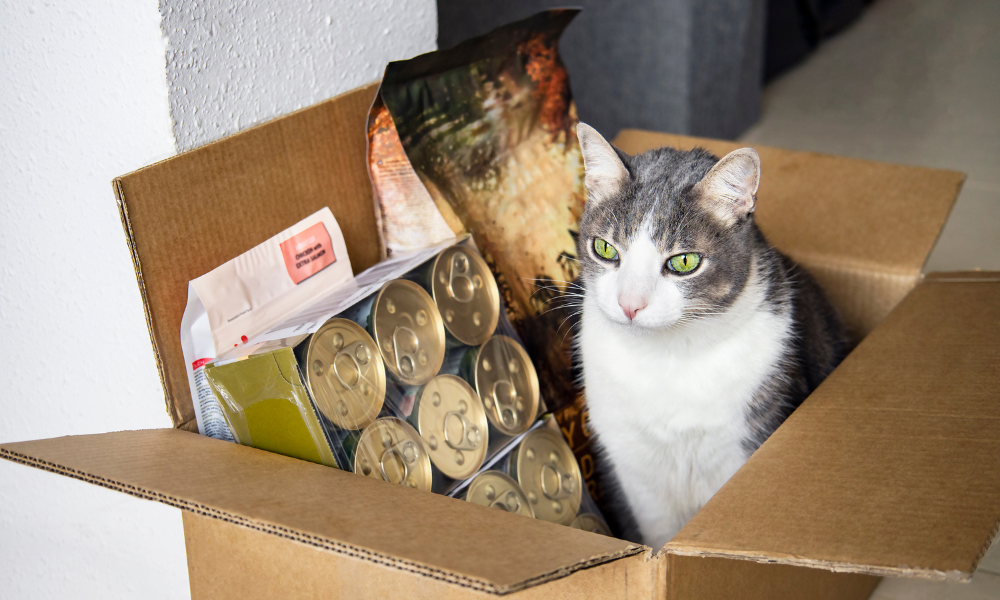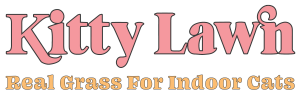Spend 5 minutes at any local pet store and the cat food choices are simply overwhelming. Even for me, a board-certified, feline-only veterinarian. It’s impossible to keep up! Picking the perfect cat food may seem like an impossible task, but let’s break it down and discuss what we should be looking for.
WSAVA – What the what?!?

You’re about to learn an acronym you’ve probably never heard of before. WSAVA stands for the World Small Animal Veterinary Association.
It’s known as an “association of associations” and is currently comprised of over 115 veterinary associations from all over the world!
WSAVA has multiple purposes, one of which is creating guidelines for standards of care based on worldwide veterinary input and opinion. They have guidelines and position statements on everything from animal welfare to pain.
One of their global guidelines in the “Nutrition” category (under the Toolkit section) is called “Guidelines on Selecting Pet Foods.” Let’s break it down (in my own CatVetLife way).
Picking the Perfect Cat Food – What’s on the packaging and labeling?

Pet food marketing is a gazillion-dollar industry (I made that number up, but you get the point). Cat food packaging has to look enticing to grab your attention amongst the many other choices.
You’ll see everything from cute kittens to mountain lions. You’ll see pictures of meat [cats are obligate carnivores and cannot be vegetarians (very rare exceptions exist with certain hypoallergenic diets but we won’t go there)] to what looks like a tasty salad! Wow, those carrots and blueberries look yummy so this must be a good food, right?
By the way, I’m not here to bash brands or price points. I just want you to make your own educated decision.
You’ll see claims that the food is “natural,” “premium,” or “holistic.” Did you know that these words are NOT regulated? Any manufacturer can use them no matter what is in the food.

The back of the package will contain the nutritional info. The breakdown of nutrients and calories is helpful but oftentimes difficult to understand unless you’re a nutritionist.
So much to take in!
Picking the Perfect Cat Food – So many brands!
 If you really want to know more about a company, start asking some questions…
If you really want to know more about a company, start asking some questions…
1. Who is in charge of nutrition and recipe development?
Just because I love my pets doesn’t mean I’m qualified to develop pet food.
Companies should employ individuals with either a PhD in Animal Nutrition or Board Certification by the American College of Veterinary Nutrition (ACVN) or the European College of Veterinary Comparative Nutrition (ECVCN).
You should be able to locate this information on a company’s website.
2. Quality control?
Quality control should be strict with many types of testing before, during and after manufacturing. Analyzing the nutrients and toxicology screens are just two of the many protocols that should be in place.
3. Has the food been studied? Is it published in peer-reviewed journals?
Companies are NOT required to do research to sell food! Does your cat food brand perform research and publish their findings? If it’s a “mom and pop” brand, then likely not.

4. Getting to know the company.
Can you easily access information on contact info via the label or their website?
I have contacted companies before asking for nutritional analysis of a certain food and was told that it was not available. That’s a red flag.
5. Who makes the food?
Do they make their own (i.e.,”Made by”) or use a third- party manufacturer (i.e.,”Made for” or “Distributed by”).”
If you can’t figure this out, beware.
Picking the Perfect Cat Food – Those confusing labels!

1. Nutritional Adequacy Statement?
All labels have a nutritional adequacy statement. In order to say a food is “complete and balanced” the food has to either
- Meet one of the Dog or Cat Food Nutrient Profiles established by the Association of American Feed Control Officials (AAFCO), or
- Pass a feeding trial using AAFCO procedures. However, the feeding trials may be short in length.
In other words, “complete” diets should have all the required nutrients.
However, diets that are “formulated for all life stages” have all the nutrients for reproduction, growth AND adults. But wait, that also means that you could be feeding food appropriate for kittens to your adult cat. That’s usually not appropriate!
Different life stages have different nutritional needs. A growing kitten has different requirements than that of a 2-year-old neutered male cat.
But wait, there’s more…
*Beware of foods labeled as intended for “short-term”, “intermittent”, or “complementary” feeding as these are not nutritionally balanced enough to be a cat’s main diet. They look like regular cat food but should not be used as so. They are for supplemental feeding only (like a treat).
2. Calories – They are all over the place!
Calories are noted as kcal (i.e. kilocalories) but you can just say calories. The calories in dry foods range from lower calorie (i.e. in the 200-something calories per cup) to high calorie (400-500 calories per cup). Canned foods are generally in a smaller range.
The calories are always on the label. You should also EASILY be able to find this info on the company website if you are researching a certain food. I cannot recommend foods that don’t easily provide these numbers.
Caloric intake is a huge factor when picking the perfect cat food. It involves more than just reading the label. Work with your vet to discuss your cat’s lifestyle and activity level.

3. Protein Levels? Cats are carnivores!
Did you know that in order to compare the percentage of protein in canned food versus dry food you have to do a math conversion? Want to know how to do this? Read the section on Comparing Pet Food Products here.
My cats eat an all-canned diet as the protein levels of canned food are generally (not always) higher and more like what they’d eat in the wild (i.e. mice!) and I love the increased moisture it provides. You can work with your veterinarian to determine what food is best for your cat and your lifestyle.
What about “high protein” dry foods? Most are a) still not as high in protein as canned food and b) are super high in calories! Check the label! Ooh, but then you have to do that math! See above…
Want to read more on the same topic from veterinary nutritional experts? I love this article from Tufts on Questions You Should Be Asking About Your Pet’s Food. It says what I just did, only in a more dignified way.
In summary, there are lots of good brands out there. Just don’t be swayed by fancy words like holistic or natural when picking the perfect cat food.
Pick a well-known brand and ask your veterinarian for their opinion as well. Have them help you come up with a feeding plan to prevent your cat from becoming overweight. Every day I hear “But my cats don’t eat that much. How can they be overweight?” Modern cats are often couch potatoes eating foods that have too many calories for their given lifestyle. Talk to your vet.
Note – I get that cats can be difficult to transition to canned food! I also understand that some cats require foods that only come in a dry version. One of my previous cats was on Royal Canin Fiber Response, which is an awesome food for treating constipation but only comes in a dry version as of 2023.
Picking The Perfect Cat Food: What do I feed my cats?
Disclaimer: I have zero personal or business attachment to any of the pet food manufacturers. I feed and generally recommend brands that put research behind their products. Furthermore, I do not get free cat food. I get a standard professional discount (just like most people do at their place of business).
My personal cats at home each have a SureFeed microchip feeder (set on Intruder Mode so that the lid closes if another cat tries to sneak a snack). I feed them twice a day but with their microchip feeders they can eat small amounts multiple times a day. That’s more like how a cat would eat in the wild.



Biscuit (8#): She currently eats Purina EN Naturals (i.e. gastrointestinal-friendly) canned food but I’ll switch that up with Royal Canin Gastrointestinal or Science Diet i/d (which stands for intestinal diet). Yes, she goes back and forth between the big 3 brands and eat ~6 oz per day.
Sioux and Bacon (11# and 8#): They both eat Science Diet c/d Multicare Stress canned food. This is a lower urinary tract support diet. They each get 7.5 oz per day.
The clinic cats are fed three times a day. Why? Because they are constantly around food in the sink, trash and other areas so we feed them more frequently to discourage them from getting into trouble.
Apache eats Science Diet i/d canned food. He gets 3 oz three times per day. But he’s also a 15# cat.
He’s currently under treatment for Gastrointestinal Lymphoma, a type of cancer that is quite amenable to treatment! Treating him was an easy decision, but it’s not always that easy.
Panther (12#) eats Science Diet c/d Multicare Stress canned food, like my male cats at home. He gets 3 oz at both breakfast and dinner and 1.5 oz at lunch. You have to hide your own lunch or he will steal it right from under you.
 Louie is our 11# scavenger. He eats Science Diet i/d canned food, 3 oz twice a day, plus a ⅛ cup of Royal Canin Satiety dry food in a puzzle feeder for lunch. Satiety is a super low-calorie, very filling cat food.
Louie is our 11# scavenger. He eats Science Diet i/d canned food, 3 oz twice a day, plus a ⅛ cup of Royal Canin Satiety dry food in a puzzle feeder for lunch. Satiety is a super low-calorie, very filling cat food.
If Louie wrote an article on Picking The Perfect Cat Food, he’d say forget about it, just feed dry food ad lib. Sorry Louie, not going to happen.
Stay tuned for upcoming posts on various ways to provide enrichment to your cats through Lickimats (used with cautions so they don’t eat the mat (!), puzzle feeders and more!
PS – FTC disclosure – As an Amazon Associate I earn from qualifying purchases.
What’s your favorite cat food? Convince me in the comments.
















2 Responses
9 mo old indoor tabby cat is losing hair on one ear.
I feed her 2 times with Purim’s cat chow and a couple of treats
Thanks for your comment! Dr. Carter regrets that she cannot provide medical advice via this website or any other out-of-clinic means. Please visit your local veterinarian for specific advice. For in-clinic consultations with Dr. Carter, please contact Cat Care Clinic at 386-671-0747.